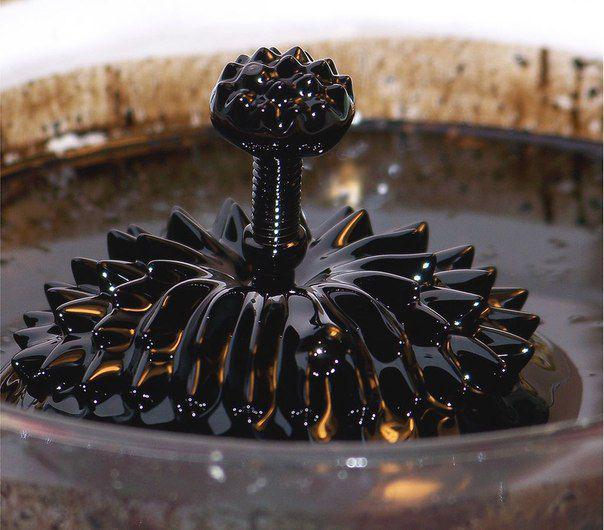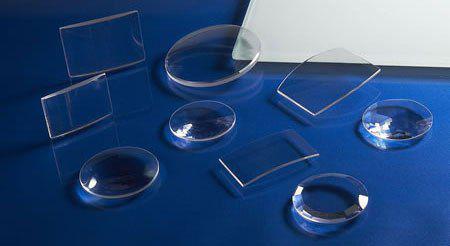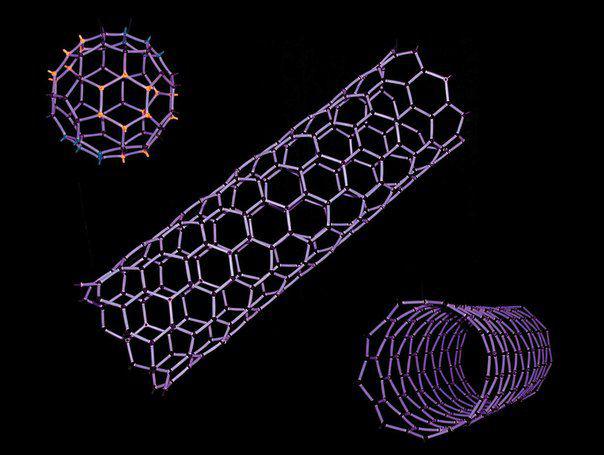Rules of physics
 Bashny.Net
Bashny.Net
In the world there are many wonderful things and unusual materials, but these may well qualify for the category of "the most amazing among invented people." Of course, these substances "violate" the rules of physics at first glance, in fact, all have been scientifically explained, although this matter does not become less wonderful.
1. ferrofluid
Ferrofluid - a magnetic fluid, from which you can form a very interesting and intricate shapes. However, while no magnetic field, ferrofluid - viscous and not how it is remarkable. But here it is necessary to act on it with a magnetic field, as its particles are arranged along the lines of - and create something indescribable ...
In practice, the ferrofluid used in different ways: for example, to ensure that the thermal conductivity of the speakers, but the method is demonstrated by the use is also very personal.
Well, the opportunity to become something solid, the liquid: depending on the influence of the magnetic field, makes this material and significant for the automotive industry, and NASA and the military.

2. Aerogel Frozen Smoke
Aerogel Frozen Smoke («frozen smoke") consists of 99 percent of air and 1 - from silicon dioxide. The result is a very impressionable Magic: the bricks hang in the air and all that. Additionally, this gel also refractories.
A variety of so-called airgel is "air-glass» (Airglass) with a density of 0, 05-0, 2 grams per cubic centimeter. It is quite transparent, and although not too well, but for thermal protection surpasses ordinary glass.
Generally, engineers, and scientists believe that in the near future airgel can find tens of applications on Earth. Here, again, helps space. In recent years, the shuttle experiments were conducted to obtain the airgel in weightlessness.
Being almost imperceptible, while the airgel can hold almost incredible gravity that 4000 times greater than the volume consumed substance, than he himself - very light. It is used in space: for example, for "catching" dust from the tails of comets and "warming" suits the astronauts. In the future, scientists say, it will appear in many homes: very much convenient materialchik.

3. perfluorocarbons
Perfluorocarbon - it is a liquid, holds a large amount of oxygen, and which, in fact, you can breathe. The substance tested in the 60-ies of the last century: in mice, demonstrating a certain percentage of effectiveness. Unfortunately, only some: laboratory mice died after a few hours spent in the containers with liquid. Scientists have come to believe that the reason - the impurity ...
Today perfluorocarbons used for ultrasound studies or even to create an artificial blood. Uncontrolled use of a substance in any case not: it is not the most environmentally friendly. The atmosphere, such as "heats" 6500 times more potent than carbon dioxide.

As well as a matrix of transistors and can be stretched elastic conductor. In a group of researchers from the University of Tokyo led by Takao Someyya (Takao Someya) first obtained by different high conductivity and chemical stability of the elastomer by introducing carbon nanotubes in a polymer matrix.
The elastic material was prepared by mixing of a black paste obtained by kneading in an ionic liquid nanotubes - bis (trifluoromethanesulfonyl) imide 1-butyl-3-methylimidazolium. The process of grinding does not give carbon nanotubes stick together in large "bundles" that helps them reduce stiffness and increases flexibility.
4. Flexible conductors
After rubbing the gel combined with fluorinated copolymer gives the material more elasticity, give it to harden and dry. The resulting film of all these operations is covered with silicone rubber, thereby forming the elastic conductor. To further increase the elasticity of the material can be perforated and it can also be applied to organic transistors. After completion of all manufacturing steps is prepared elastic sheet whose properties are not changed when it is stretched to 70%.
To demonstrate the reality and the cost-effectiveness of the proposed approach, Japanese researchers used a small-scale prototype of the printer for flexible conductor sizes 20 to 20 cm. Takao Someyya believes that the process of production of flexible conductors can be scaled up to industrial production is much larger in size flexible and resilient integrated electrical circuits. According to the researchers, this technique can reduce the cost of manufacture of flexible displays, as well as to create an artificial skin for robots and systems interface for human-computer interaction.

5. Non-Newtonian fluid
Fluid whose viscosity depends on the velocity gradient are called non-Newtonian.
Scientists are looking for the path of this ability in the development of non-Newtonian fluid army gear and shape. To soft and comfortable fabric under the bullets getting hard - and turned into a vest.

6. Transparent alumina
Transparent and yet sturdy metal are planning to use both to create a better army equipment, as well as in the automotive industry and even in the production of windows. Why not: you can see well, and do not beat.

7. Carbon nanotubes
Carbon nanotubes are already present in the fourth paragraph of Article, and voila - a new meeting. And all because of the possibility of them really wide, and talk about all sorts of delights for hours. In particular, it is - the most durable of all human invention materials.
With the help of this material is already creating heavy-duty thread, ultra-compact computer processors, and many others, and in the future will only to increase the rate of: super-efficient batteries, more efficient solar panels and even the cable for future space elevator ...

Source:
1. ferrofluid
Ferrofluid - a magnetic fluid, from which you can form a very interesting and intricate shapes. However, while no magnetic field, ferrofluid - viscous and not how it is remarkable. But here it is necessary to act on it with a magnetic field, as its particles are arranged along the lines of - and create something indescribable ...
In practice, the ferrofluid used in different ways: for example, to ensure that the thermal conductivity of the speakers, but the method is demonstrated by the use is also very personal.
Well, the opportunity to become something solid, the liquid: depending on the influence of the magnetic field, makes this material and significant for the automotive industry, and NASA and the military.

2. Aerogel Frozen Smoke
Aerogel Frozen Smoke («frozen smoke") consists of 99 percent of air and 1 - from silicon dioxide. The result is a very impressionable Magic: the bricks hang in the air and all that. Additionally, this gel also refractories.
A variety of so-called airgel is "air-glass» (Airglass) with a density of 0, 05-0, 2 grams per cubic centimeter. It is quite transparent, and although not too well, but for thermal protection surpasses ordinary glass.
Generally, engineers, and scientists believe that in the near future airgel can find tens of applications on Earth. Here, again, helps space. In recent years, the shuttle experiments were conducted to obtain the airgel in weightlessness.
Being almost imperceptible, while the airgel can hold almost incredible gravity that 4000 times greater than the volume consumed substance, than he himself - very light. It is used in space: for example, for "catching" dust from the tails of comets and "warming" suits the astronauts. In the future, scientists say, it will appear in many homes: very much convenient materialchik.

3. perfluorocarbons
Perfluorocarbon - it is a liquid, holds a large amount of oxygen, and which, in fact, you can breathe. The substance tested in the 60-ies of the last century: in mice, demonstrating a certain percentage of effectiveness. Unfortunately, only some: laboratory mice died after a few hours spent in the containers with liquid. Scientists have come to believe that the reason - the impurity ...
Today perfluorocarbons used for ultrasound studies or even to create an artificial blood. Uncontrolled use of a substance in any case not: it is not the most environmentally friendly. The atmosphere, such as "heats" 6500 times more potent than carbon dioxide.

As well as a matrix of transistors and can be stretched elastic conductor. In a group of researchers from the University of Tokyo led by Takao Someyya (Takao Someya) first obtained by different high conductivity and chemical stability of the elastomer by introducing carbon nanotubes in a polymer matrix.
The elastic material was prepared by mixing of a black paste obtained by kneading in an ionic liquid nanotubes - bis (trifluoromethanesulfonyl) imide 1-butyl-3-methylimidazolium. The process of grinding does not give carbon nanotubes stick together in large "bundles" that helps them reduce stiffness and increases flexibility.
4. Flexible conductors
After rubbing the gel combined with fluorinated copolymer gives the material more elasticity, give it to harden and dry. The resulting film of all these operations is covered with silicone rubber, thereby forming the elastic conductor. To further increase the elasticity of the material can be perforated and it can also be applied to organic transistors. After completion of all manufacturing steps is prepared elastic sheet whose properties are not changed when it is stretched to 70%.
To demonstrate the reality and the cost-effectiveness of the proposed approach, Japanese researchers used a small-scale prototype of the printer for flexible conductor sizes 20 to 20 cm. Takao Someyya believes that the process of production of flexible conductors can be scaled up to industrial production is much larger in size flexible and resilient integrated electrical circuits. According to the researchers, this technique can reduce the cost of manufacture of flexible displays, as well as to create an artificial skin for robots and systems interface for human-computer interaction.

5. Non-Newtonian fluid
Fluid whose viscosity depends on the velocity gradient are called non-Newtonian.
Scientists are looking for the path of this ability in the development of non-Newtonian fluid army gear and shape. To soft and comfortable fabric under the bullets getting hard - and turned into a vest.

6. Transparent alumina
Transparent and yet sturdy metal are planning to use both to create a better army equipment, as well as in the automotive industry and even in the production of windows. Why not: you can see well, and do not beat.

7. Carbon nanotubes
Carbon nanotubes are already present in the fourth paragraph of Article, and voila - a new meeting. And all because of the possibility of them really wide, and talk about all sorts of delights for hours. In particular, it is - the most durable of all human invention materials.
With the help of this material is already creating heavy-duty thread, ultra-compact computer processors, and many others, and in the future will only to increase the rate of: super-efficient batteries, more efficient solar panels and even the cable for future space elevator ...

Source:
Tags
See also
Interesting facts about Ancient Egypt
Cult "Matrix" for 15 years. 15 interesting facts
The most interesting facts about snakes
100 weird and interesting facts about the human body
Interesting facts about the famous myths
New Year: the most interesting facts
Interesting facts about pornography
Interesting facts about Antarctica
Interesting facts about dreams
Interesting facts from the shooting
















